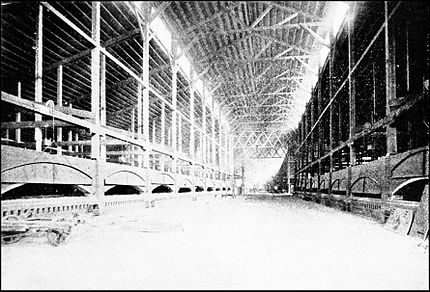pany prospered for some time, but through unwise management finally failed. But the American plate-glass industry, though apparently doomed to suffer severe reverses, was not doomed to die. In 1869, two years before the Lenox failure, a carefully designed plant was put into operation at New Albany, Ind., by Mr. John B. Ford. He imported the first grinding and polishing machinery from England. Although these works have been operated continuously ever since then, and are now reasonably successful, they had to run the gantlet of early reverses. Their owner, Mr. W. C. De Pauw, stated before the tariff commission that up to 1879 no money was made at his own works, and that he believed other

Interior View of the Casting Hall at Ford City, Pa.
manufacturers of plate glass in America had had a similar experience. The industry up to that year seems indeed to have been one succession of financial disasters. Yet these failures do not appear to have discouraged their promoters. Between 1870 and 1875 Mr. Ford established other works at Jeffersonville, Ind., and at Louisville, Ky. About the same time a large plant was also built at St. Louis, and, like the others, was equipped with English machinery. It was at that time the largest factory in the United States. The industry was slow in establishing itself at Pittsburg, but it has since reached its greatest development in that district. The Pittsburg Plate Glass Company began operations in 1883, their first factory being at Creighton. The monthly output was about
